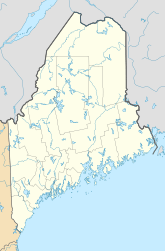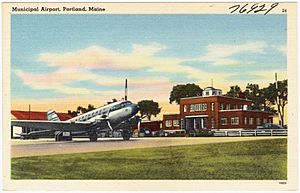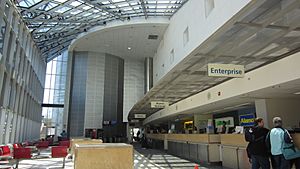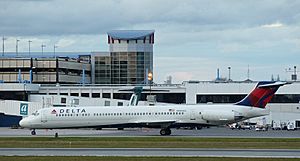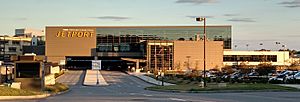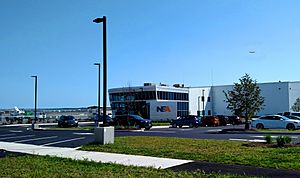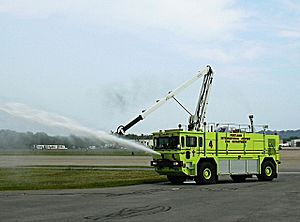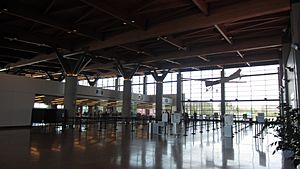Portland International Jetport facts for kids
Quick facts for kids
Portland International Jetport
|
|||||||||||||||
|---|---|---|---|---|---|---|---|---|---|---|---|---|---|---|---|
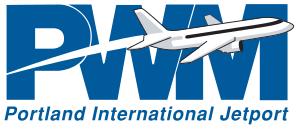 |
|||||||||||||||

The jetport in 2008, looking west
|
|||||||||||||||
| Summary | |||||||||||||||
| Airport type | Public | ||||||||||||||
| Owner/Operator | City of Portland | ||||||||||||||
| Serves | Portland, Maine, U.S. | ||||||||||||||
| Location | Portland, Maine, U.S. | ||||||||||||||
| Opened | August 1, 1931 | ||||||||||||||
| Focus city for | Elite Airways | ||||||||||||||
| Elevation AMSL | 76 ft / 23 m | ||||||||||||||
| Coordinates | 43°38′46″N 070°18′33″W / 43.64611°N 70.30917°W | ||||||||||||||
| Website | www.portlandjetport.org | ||||||||||||||
| Map | |||||||||||||||
| Runway | |||||||||||||||
|
|||||||||||||||
| Statistics | |||||||||||||||
|
|||||||||||||||
|
Source: FAA and Portland Jetport.
|
|||||||||||||||
The Portland International Jetport (airport codes: PWM, KPWM) is a public airport. It is located about two miles (3 km) west of downtown Portland, Maine, in the United States. The City of Portland owns and runs the airport. Part of the airport, including its main runway, is in the nearby city of South Portland. The Jetport covers 726 acres (293 hectares) of land.
This airport is the busiest in Maine. In 2018, over two million passengers used the Jetport. This was a new record, beating the 1.86 million passengers from 2017.
The Jetport has become very popular. This is partly because of low-cost airlines like Southwest Airlines and JetBlue. Also, Portland has become a popular place for tourists to visit. A study in 2011 found that PWM was the most affordable airport in its area. It was also the third most affordable in all of New England.
In October 2011, the Jetport finished a big project. They spent $75 million to make their terminal bigger and better. This allowed more airlines to offer flights. It also added more services for passengers.
In 2020, PWM got $4.5 million from the government. This money was used to build a 1,200-foot (366 m) long taxiway. This taxiway connects the airport's runways.
Contents
History of Portland International Jetport
How the Airport Started
The airport began in the late 1920s. Dr. Clifford "Kip" Strange needed a place for his JN-4 "Jenny" Biplane. It was first called Stroudwater Field. The first commercial flight happened on August 1, 1931. Boston-Maine Airways started a flight from Portland to Boston.
Two years later, the city of Portland bought the airfield. They changed its name to Portland-Westbrook Municipal Airport. "Westbrook" was the name of a nearby city. The airport started to look like it does today in the 1950s. A new runway, 11/29, was built in 1957. It was made longer in 1966. The current main terminal opened in 1968. This was when jet flights first started.
Jet Flights and New Airlines (1960s-1970s)
For a while, Boston-Maine Airways (later Northeast Airlines) was the only airline in Portland. In 1968, jet flights began. Portland got its first nonstop flight beyond Boston. Northeast DC-9 planes flew to LaGuardia Airport in New York.
In 1970, Aroostook Airways started flights. They flew between Presque Isle and Portland. They also stopped in Augusta and Bangor. In 1972, Air New England also began service in Portland.
Later in 1972, Delta Air Lines bought Northeast Airlines. Delta kept flying to Bangor, Boston, and New York. By 1979, Delta had also added flights to Burlington, Vermont.
Growth and Low-Cost Carriers (1980s-1990s)
In 1981, Air New England stopped flying from Portland. The airport's passenger terminal got bigger in 1980. They added more baggage carousels and jetways. In 1982, Delta Air Lines started a nonstop flight to Cincinnati. This was the first nonstop flight from Portland beyond New York.
Peoplexpress Airlines arrived in 1983. This was the first low-cost airline at the Jetport. They were known for very cheap prices. They flew between Portland and Newark. Today, United Airlines still flies this route. United Airlines bought Peoplexpress in 1987.
In June 1983, United Airlines also started flying from Portland. They first flew the Burlington route. Later, they added nonstop flights to Chicago. In 1986, US Airways (then USAir) began flights to Philadelphia and Pittsburgh.
Continental Airlines arrived in 1987. They bought Peoplexpress and took over their flights. Also in 1987, Business Express started. This airline offered flights from Portland to Boston, New York-LaGuardia, and Presque Isle.
In 1995, the terminal building was improved again. They added two more boarding gates. They also made more space for ticketing, lounges, and food places. An international customs area was also added.
Changes in the New Millennium (2000s)
After the September 11 attacks, many airlines cut flights. Airlines started using smaller regional jets or turboprop planes at PWM. In late 2002, American Eagle stopped flying to the Jetport. In 2004, Runway 11/29 was made longer to 7,200 feet (2,195 m).
On September 1, 2005, Delta Air Lines stopped using its larger planes for flights from PWM. They used smaller planes operated by Delta Connection. However, in the late 2000s, Delta brought back its larger planes to Portland.
In 2005, Independence Air started flying from Portland. They were a low-cost carrier. On May 1, 2005, Independence added a daily flight to Washington Dulles. They used an Airbus A319 plane. This was the first time an Airbus plane flew from Portland.
After Independence Air went out of business, Portland had no low-cost airline. This caused ticket prices to go up. Passenger numbers went down. To fix this, JetBlue Airways started service on May 23, 2006. They offered four daily flights to New York-JFK. They used Airbus A320 and Embraer 190 jets. This made JetBlue the second-largest airline at the Jetport very quickly. This new service helped lower ticket prices for everyone. This is known as the "Southwest Effect."
On June 7, 2007, AirTran Airways began seasonal flights. They flew to Baltimore and Orlando. AirTran was the second low-cost airline in Portland. This was Portland's first nonstop flight to Florida. In 2007, Portland had a record number of passengers. The new flights caused a 17% increase in passengers from the year before.
In 2008, Delta Air Lines started daily flights to Atlanta. They used a McDonnell Douglas MD-88 plane. A new airline, New England Air Transport (NEAT), began flights within Maine. They flew to Aroostook County.
In the fall of 2009, PWM built a special plane spotting area. It is on Aviation Boulevard in South Portland. This allows people who love planes to watch flights arrive and depart. Before 2001, people could watch planes from other roads. But this was stopped for security reasons. The new area has a sign showing some of the planes seen at the Jetport.
Modern Airport Improvements (2010s)
In 2010, Air Canada announced new flights from Toronto, Canada. This included a flight to Portland. The Portland-Toronto service began on May 17, 2010. It was operated by Air Georgian using Beechcraft 1900D planes. Air Canada stopped flying from Portland on March 1, 2013. This meant PWM no longer had regular international flights.
The Jetport started building its expanded terminal in 2010. This was part of several big improvements. The main expansion of the terminal happened throughout 2010 and 2011. The new, bigger terminal opened on October 2, 2011. This $75 million project brought many changes. It improved check-in areas and security. It also changed the airport roads and expanded the parking garage.
The new terminal uses a geothermal heating and cooling system. This is the largest of its kind in Maine. It is expected to save a lot of heating oil each year. Other improvements were also planned. These included making the cargo area bigger. They also planned to improve the airport's deicing facilities. Runway 18/36 was also planned to be made longer.
A study in June 2011 found PWM to be an affordable airport. It was compared to other airports in the region. These included Manchester, Bangor, and Logan. PWM was the third most affordable in New England. Only Bradley and T. F. Green were cheaper.
Airlines and Destinations
Passenger Flights
| Airlines | Destinations |
|---|---|
| American Airlines | Charlotte Seasonal: Philadelphia |
| American Eagle | Charlotte, Philadelphia, Washington–National |
| Delta Air Lines | Atlanta Seasonal: Detroit |
| Delta Connection | Detroit, New York–LaGuardia |
| Elite Airways | Naples (FL), Orlando/Melbourne, Sarasota Seasonal: Long Island/Islip |
| JetBlue Airways | New York–JFK |
| Southwest Airlines | Baltimore Seasonal: Chicago–Midway, Orlando |
| United Airlines | Seasonal: Chicago–O'Hare |
| United Express | Chicago–O'Hare, Newark, Washington–Dulles |
Cargo Flights
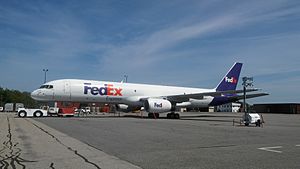
| Airlines | Destinations |
|---|---|
| FedEx Express | Burlington (VT), Memphis |
| FedEx Feeder operated by Wiggins Airways |
Bangor, Hartford, Manchester (NH), Presque Isle |
Getting to the Airport
You can reach the airport from I-95 (the Maine Turnpike) and I-295. The Jetport has many parking areas and two parking garages. A shuttle bus service called The Portland Explorer is also available. It takes people to nearby hotels and other transportation. This includes the Amtrak Downeaster train service. It also connects to Concord Coach Lines bus service at the Portland Transportation Center.
See also
 In Spanish: Jetport Internacional de Portland para niños
In Spanish: Jetport Internacional de Portland para niños


